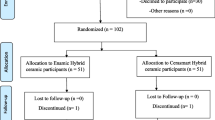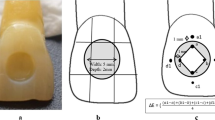Abstract
The purpose of this study was to evaluate the color difference of nanohybrid and ormocer-based composite resins with different thicknesses when 4 different shades of resin luting cement were used. 56 disc specimens of each composite resin (Aelite aesthetic enamel, Ceram-X mono) with 0.5 and 1 mm thicknesses were fabricated. Baseline color measurements were performed using a clinical spectrophotometer. The specimens of each thicknesses of each resin were randomly divided into 4 groups according to the shades of resin luting cement (white/A1, yellow/universal/A3, transparent and white opaque) (n = 7). Mixed resin cement was applied onto the resin specimens using a Teflon mold in 0.1 mm thickness. Color measurements of cemented composite resin specimens were repeated and color difference (∆E) between baseline and after cementation measurements was calculated. ANOVA and Tukey’s test were used for statistical analysis. The opaque shade had significantly increased ∆E values as compared to the other shades (p < 0.05). For all shades except white opaque in both thicknesses, ∆E values of aelite aesthetic enamel were higher as compared to Ceram-X mono. There is no significant difference between 2 thicknesses for both resins in terms of ∆E values. The shade of resin cement and the type of the resin affected the final color; however, the thickness of composite resin had no influence on the final color of restoration. Selecting the shade of resin luting cement before cementation of indirect composite laminate restoration is important to achieve final color match.
Similar content being viewed by others
References
Fahl JN. The direct/indirect composite resin veneers: a case report. Pract Periodontics Aesthet Dent. 1996;8:627–38.
Sadowsky SJ. An overview of treatment considerations for esthetic restorations: a review of the literature. J Prosthet Dent. 2006;96:433–42.
Alabdulwahhab BM, AlShethry MA, AlMoneef MA, AlManie MA, AlMaziad MM, AlOkla MS. The effect of dental adhesive on final color match of direct laminate veneer (DLV). In vitro study. J Esthet Restor Dent. 2015;27:307–13.
Coelho-de-Souza FH, Gonçalves DS, Sales MP, Erhardt MC, Corrêa MB, Opdam NJ, et al. Direct anterior composite veneers in vital and non-vital teeth: a retrospective clinical evaluation. J Dent. 2015;43:1330–6.
Re D, Augusti G, Amato M, Riva G, Augusti D. Esthetic rehabilitation of anterior teeth with laminates composite veneers. Case Rep Dent. 2014;2014:849273.
Ferraz Caneppele TM, Rocha DM, Màximo Araujo MA, Valera MC, Salazar Marocho SM. Abrasion resistance of direct and indirect resins as a function of a sealant veneer. Indian J Dent Res. 2014;25:381–5.
Turgut S, Bagis B. Effect of resin cement and ceramic thickness on final color of laminate veneers: an in vitro study. J Prosthet Dent. 2013;109:179–86.
Alqahtani MQ, Aljurais RM, Alshaafi MM. The effects of different shades of resin luting cement on the color of ceramic veneers. Dent Mater J. 2012;31:354–61.
van Dijken JW, Pallesen U. Four-year clinical evaluation of Class II nano-hybrid resin composite restorations bonded with a one-step self-etch and a two-step etch-and-rinse adhesive. J Dent. 2011;39:16–25.
Davis N. A nanotechnology composite. Compend Contin Educ Dent. 2003;24:662 (665-667, 669-670).
Kalra S, Singh A, Gupta M, Chadha V. Ormocer: an aesthetic direct restorative material; an in vitro study comparing the marginal sealing ability of organically modified ceramics and a hybrid composite using an ormocer-based bonding agent and a conventional fifth-generation bonding agent. Compend Contin Educ Dent. 2012;3:48–53.
Attar N, Tam LE, McComb D. Mechanical and physical properties of contemporary dental luting agents. J Prosthet Dent. 2003;89:127–34.
Ozturk E, Chiang YC, Cosgun E, Bolay Ş, Hickel R, Ilie N. Effect of resin shades on opacity of ceramic veneers and polymerization efficiency through ceramics. J Dent. 2013;41:e8–14.
Turgut S, Bagis B. Colour stability of laminate veneers: an in vitro study. J Dent. 2011;39:e57–64.
Ahn JS, Lee YK. Difference in the translucency of all-ceramics by the illuminant. Dent Mater. 2008;24:1539–44.
Ruyter IE, Nilner K, Moller B. Color stability of dental composite resin materials for crown and bridge veneers. Dent Mater. 1987;3:246–51.
Lee YK, Yu B, Lee SH, Cho MS, Lee CY, Lim HN. Variation in instrument-based color coordinates of esthetic restorative materials by measurement method-a review. Dent Mater. 2010;26:1098–105.
Paul SJ, Peter A, Rodoni L, Pietrobon N. Conventional visual vs spectrophotometric shade taking for porcelain-fused-to-metal crowns: a clinical comparison. Int J Periodont Restor Dent. 2004;24:222–31.
Judeh A, Al-Wahadni A. A comparison between conventional visual and spectrophotometric methods for shade selection. Quintessence Int. 2000;40:e69–79.
Paul S, Peter A, Pietrobon N, Hämmerle CH. Visual and spectrophotometric shade analysis of human teeth. J Dent Res. 2002;81:578–82.
Johnston WM. Color measurement in dentistry. J Dent. 2009;37:e2–6.
Kuehni RG, Marcus RT. An experiment in visual scaling of small color differences. Color Res Appl. 1979;4:83–91.
Ragain JC Jr, Johnston WM. Minimum color differences for discriminating mismatch between composite and tooth color. J Esthet Restor Dent. 2001;13:41–8.
Johnston WM, Kao EC. Assessment of appearance match by visual observation and clinical colorimetry. J Dent Res. 1989;68:819–22.
Peutzfeldt A. Dual-cure resin cements: in vitro wear and effect of quantity of remaining double bonds, filler volume, and light curing. Acta Odontol Scand. 1995;53:29–34.
Vichi A, Ferrari M, Davidson CL. Influence of ceramic and cement thickness on the masking of various types of opaque posts. J Prosthet Dent. 2000;83:412–6.
Li Q, Yu H, Wang YN. Spectrophotometric evaluation of the optical influence of core build-up composites on all-ceramic materials. Dent Mater. 2009;25:158–65.
Garber D. Porcelain laminate veneers: ten years later. Part I: tooth preparation. J Esthet Dent. 1993;5:56–62.
Magne P, Versluis A, Douglas WH. Effect of luting composite shrinkage and thermal loads on the stress distribution in porcelain laminate veneers. J Prosthet Dent. 1999;81:335–44.
Chang J, Da Silva JD, Sakai M, Kristiansen J, Ishikawa-Nagai S. The optical effect of composite luting cement on all ceramic crowns. J Dent. 2009;37:937–43.
Xing W, Jiang T, Ma X, Liang S, Wang Z, Sa Y, et al. Evaluation of the esthetic effect of resin cements and try-in pastes on ceromer veneers. J Dent. 2010;38:e87–94.
Schulze KA, Marshall SJ, Gansky SA, Marshall GW. Color stability and hardness in dental composites after accelerated aging. Dent Mater. 2003;19:612–9.
Lee YK. Influence of scattering/absorption characteristics on the color of resin composites. Dent Mater. 2007;23:124–31.
Lim YK, Lee YK, Lim BS, Rhee SH, Yang HC. Influence of filler distribution on the color parameters of experimental resin composites. Dent Mater. 2008;24:67–73.
Mikhail SS, Schricker SR, Azer SS, Brantley WA, Johnston WM. Optical characteristics of contemporary dental composite resin materials. J Dent. 2013;41:771–8.
Miyagawa Y, Powers JM, O’Brien WJ. Optical properties of direct restorative materials. J Dent Res. 1981;60:890–4.
Shortall AC, Palin WM, Burtscher P. Refractive index mismatch and monomer reactivity influence composite curing depth. J Dent Res. 2008;87:84–8.
Kurtulmus-Yilmaz S, Cengiz E, Ulusoy N, Ozak ST, Yuksel E. The effect of home-bleaching application on the color and translucency of five resin composites. J Dent. 2013;41:e70–5.
Balderamos LP, O’Keefe KL, Powers JM. Color accuracy of resin cements and try-in pastes. Int J Prosthodont. 1997;10:111–5.
Terzioğlu H, Yilmaz B, Yurdukoru B. The effect of different shades of specific luting agents and IPS empress ceramic thickness on overall color. Int J Periodontics Restor Dent. 2009;29:499–505.
Kürklü D, Azer SS, Yilmaz B, Johnston WM. Porcelain thickness and cement shade effects on the colour and translucency of porcelain veneering materials. J Dent. 2013;41:1043–50.
Ferraris F, Diamantopoulou S, Acunzo R, Alcidi R. Influence of enamel composite thickness on value, chroma and translucency of a high and a nonhigh refractive index resin composite. Int J Esthet Dent. 2014;9:382–401.
Acknowledgement
The authors would like to thank Dr. Hasan Guney Yilmaz for statistical analyses.
Author information
Authors and Affiliations
Corresponding author
Ethics declarations
Conflict of interest
The authors declares that they have no conflict of interest.
Rights and permissions
About this article
Cite this article
Cengiz, E., Kurtulmus-Yilmaz, S., Karakaya, I. et al. Color difference of composite resins after cementation with different shades of resin luting cement. Odontology 106, 181–186 (2018). https://doi.org/10.1007/s10266-017-0311-8
Received:
Accepted:
Published:
Issue Date:
DOI: https://doi.org/10.1007/s10266-017-0311-8




